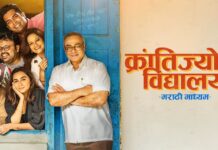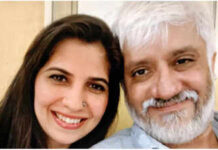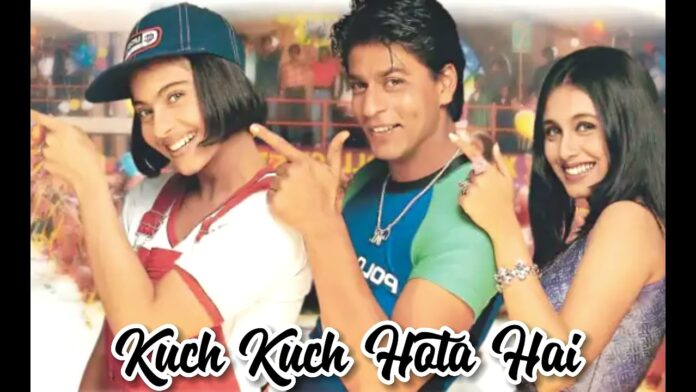KUCH KUCH HOTA HAI
Dharma Productions’ Kuch Kuch Hota Hai is a love story with a difference. It is about a guy whom two girls love. He gets married to one but the other girl is not able to forget him. Destiny brings the guy and the other girl together again but by that time, she is engaged to get married to another boy. How the old flames are rekindled forms the latter part of the film.
The story may not be novel but the presentation by debut-making director Karan Johar is definitely very novel and extremely fresh. That the young director is intelligent is borne out not just by his deft handling of a difficult and sensitive subject but also by his mixture of fares for the young audience and the ladies.
The first half is youthful and very modern in thought. The second half is also youthful but it is here that Indian and ladies sentiments have been pumped in in a large measure so that ultimately, it is the post-interval portion which moves the viewer emotionally. What’s more, the drama looks so believable that the viewer is more likely to get carried away by the entire play. There are loose moments at a few places but the overall impact is so wonderful, so brilliant that one wouldn’t even want to think of the few dull moments.
A lovely screenplay is complemented by natural dialogues. Several comedy punches are true-to-life, making the film still more believable. Another intelligent departure which Karan makes from several other seasoned directors is that at least at two or three places, he gives reason to the audience to cry and then, immediately thereafter, to smile and even laugh. So one laughs while one is still crying!
Shah Rukh Khan does an excellent job, first as the fun-loving college boy and then as a mature father with the heart of a child. Kajol proves yet again that she is the best actress we have on the scene today. Her expressions are absolutely marvellous, her acting is almost flawless. The girl should pick up several awards for a performance which will be widely discussed. Ranee Mukerji does well in a brief role. Salman Khan is fantastic in a special appearance. His entry will bring the house down, such is the build-up of the drama at that point. His dance is terrific. Johny Lever is very good. Archna Pooran Singh is really effective in a brief role. Anupam Kher does a good job in his distinctive style. Reema and Himani Shivpuri are effective. Sana Saeed acts with a rare confidence. But the guy who deserves kudos is the little Sardar (in the film), Parzan Dastur. He is, in two words, unbelievably superb. Neelam makes a cute special appearance, playing herself.
Karan Johar is a fabulous addition to the list of brainy writer-directors. In his very first film, he proves that clarity of thought and Indianness in content of one’s venture are two pre-requisites to make it to the top bracket. Karan has made it! Look, for instance, the seasoned handling of difficult scenes like the one in which Shah Rukh Khan and Kajol meet after years, the one where her saree is blown by the wind, revealing her anatomy, the one in which news of postponement of Kajol and Salman’s marriage is broken… the list is long.
Jatini Lalit’s music may not have that quality of being an instant hit but it has melody which will see the music grow day by day. Besides the title song, which is already popular, ‘Saajanji ghar aaye’, ‘Ladki badi anjaani hai’ and ‘Tujhe yaad na meri aaye’ are very appealing. Song picturisations (Farah Khan) enhance the impact a great deal. The picturisations are colourful, lively and fresh. Camerawork is extraordinary. Art direction (Sharmishtha Roy) is wonderful. Technical aspects are of a high order. Production values are lavish. Editing is crisp.
On the whole, Kuch Kuch Hota Hai is not a hit, not a super-hit but a super-duper hit, a blockbuster which, besides fetching box-office rewards, will also bring in many awards.
Released on 16-10-’98 at Liberty and 16 other cinemas of Bombay thru Yashraj Film Distributors. Publicity: bumper. Opening: extraordinary. …….Also released all over. Opening was bumper everywhere.
SALIM AKHTAR APOLOGISES TO CBFC
Producer Salim Akhtar has apologised to CBFC chief Asha Parekh, regional officer Sanjeevani Kutty, other CBFC officials and members of the CBFC board. In a letter addressed to Asha Parekh, Salim has stated that he was not satisfied with the decisions of the Examining and Revising Committees of the CBFC and had, therefore, staged a protest and also given interviews to the press, which were critical of the CBFC. He has also mentioned in the said letter that he and his unit members never meant to hurt the feelings of anybody at the CBFC, and if anybody had felt hurt, he apologised for the same. He has assured Asha Parekh that such things would not happen in future.
It may be recalled that the unit of producer Salim Akhtar had on 20th September sported black ribbons on their arms, against the CBFC’s attitude towards Mehndi.
BAIL FOR SALMAN KHAN
Salman Khan was granted bail by the sessions court in Jodhpur on 17th October (today). The judge has asked him to deposit his passport with the court within a week and to furnish a surety of Rs. 2 lakh.
Earlier, Salman Khan, who was on 12th October arrested following his alleged involvement in a poaching case near Jodhpur, was remanded to judicial custody till 26th October by the additional chief judicial magistrate in Jodhpur on 16th. After the judge passed the order for remand, the actor was taken to the central jail in Jodhpur.
Saif Ali Khan, Neelam, Tabu and Sonali Bendre, who were with Salman during the time he is alleged to have killed some black bucks and chinkaras, were granted bail earlier. Salman faces three cases of poaching of the wild animals. A case under the Arms Act was also registered against him for possession of arms, but another court in Jodhpur granted him bail in that case after he surrendered the arms allegedly used in killing two chinkaras.
Saif, Neelam, Tabu and Sonali earlier returned from Jodhpur where the unit was shooting for Rajshri’s Hum Saath Saath Hain.
In a shocking incident close on the heels of Salman’s arrest, the Maharashtra forest department seized two spotted deer, a peacock and a black buck during a raid on the Panvel (near Bombay) farmhouse of Salman’s father, Salim Khan. The police claim that the endangered animals have been held captive at the farmhouse for the last 6 months. Writer Salim Khan applied for anticipatory bail on 16th following the raid.
YOU ASKED IT
Is this week’s release, Bade Miyan Chote Miyan, the costliest film as far as distribution rights are concerned?
– Yes, it is the costliest film so far. It has generally been sold at 2.25 to 2.35 crore per major circuit but the smaller circuits have gone for as much as 2.75 to 3 crore.
You keep writing that film prices should come down but they seem to be going up. Comment.
– Distributors keep cribbing that they are finished because of high prices but they seem to be buying new films at high prices all the same. Comment.
With a sudden rush of big forthcoming releases, don’t you think, there’ll be a shortage of cinemas for further releases?
– Yes, the cinema shortage will be felt from now onwards. On an average, there’ll be one major release every week for a couple of months at least.
FILM INDUSTRY & CENSORSHIP
Censorship has always had the film industry on tenterhooks. Given below are important developments/policies/appointments relating to censorship of films in the last 25 years.
* Censors have been extremely strict since the seventies and even before that. In 1975, exhibition of Aandhi was suspended by the government. The ban was finally lifted after the film was revised. The negative of Kissa Kursee Ka was confiscated by the government in the same year.
* A new censor policy was formulated in 1976, which adversely affected the industry. Many releases were postponed as reshooting and drastic cutting became necessary to conform to the new policy.
* In 1977, the then I & B minister, L.K. Advani, announced that censorship would be rationalised. Censors became liberal to an extent in 1977 after two harsh years.
* A 10-point censor guideline was published by the government in January ’78. This brought some relief to harassed producers. But as the year progressed, censors became strict again.
* The Central Board of Film Censors conducted a public survey on the prevailing standard of censorship in 1978. Satyam Shivam Sundaram was taken as a test case.
* In 1979 , it was decided to censor all Hindi films (even if produced in Madras or Calcutta) in Bombay only.
* The collector of Bombay in 1980 prohibited trials of censored films in preview theatres without obtaining prior permission.
* Hrishikesh Mukherjee took over as Censor chairman in 1981, and producers heaved a sigh of relief.
* 1982 was a terrible year vis-à-vis censors. About 50% of the films faced either censor trouble or delay at the censor office. Meri Awaaz Suno was banned by the Central government in 1982, after its release. The ban was lifted when the producer agreed to a few cuts. But before that, several high courts stayed the government ban. The matter reached the Supreme Court.
* Censor problems were minimal in 1983. Bikram Singh was appointed censor chairman in that year. The new name for the censor board, Central Board of Film Certification (CBFC), was given in 1983. The new gradings — ‘UA’ and ‘S’ — in film certification were also introduced in 1983.
* In 1984, film re-certification was discontinued. Earlier, films were required to be re-certified after 10 years. But from ’84, certificates issued once were valid forever. But censor problems continued to haunt producers.
* A Film Certification Appellate Tribunal (FCAT) was set up in 1984 with Vyas Dev Mishra, retired chief justice of Himachal Pradesh, as its head. But produces continued to face problems at the censors’ hands.
* Censors were strict as usual in 1985 too. Censorship was put under the ministry of human resource development in that year. In the same year, the censor certificate of Teri Meherbaniyan was changed from ‘A’ to ‘U’ and that of Ram Teri Ganga Maili, from ‘U’ to ‘UA’. However, a long kiss was passed in Saagar in the same year. It was, perhaps, the beginning of a liberal attitude towards sex in films.
* 1986 had many films being referred to the CBFC’s revising committee. Some films were ultimately cleared by the Tribunal. A Marathi film, Maficha Sakshidar (Hindi version: Phansi Ka Phanda) got the certificate through court.
* In 1987 also, the Film Certification Appellate Tribunal was quite busy. It cleared more than half-a-dozen films.
* Pati Parmeshwar was in censor hot waters for a year-and-a-half and was finally okayed by the Supreme Court in 1989. The CBFC had appealed in the Supreme Court against the Bombay high court order.
* New and stricter censor guidelines were issued in 1989.
* B.P. Singhal, a retired police officer, was appointed CBFC chairman in 1990, after which censorship became very strict. It was like a virtual police raj at the CBFC.
* Shakti Samanta replaced B.P. Singhal as CBFC chairman in 1991.
* Sadak was called by the I & B ministry after it was cleared by the CBFC in 1991. The ministry refused a certificate to the film. Finally, an out-of-court settlement was arrived at after the producer moved the high court.
* Justice M.P. Verma became the Film Certification Appellate Tribunal chairman in 1991.
* The Bandit Queen was banned by the court in 1994 on a plea made by dacoit Phoolan Devi on whose life the film was based. After being cleared and released in Jan. ’96, it was again banned by the Delhi high court. The film was finally cleared by the Supreme Court. The film contained a lot of swear words.
* Mira Nair’s Kama Sutra – A Tale Of Love faced terrible censor trouble in 1996. Ultimately, the Bombay high court ordered the Hindi dubbed version of the film to be censored without any extra cuts in visuals over and above the cuts in the original version.
* Asha Parekh was appointed chairperson of the CBFC in 1998.
BLOCKBUSTERS OF 25 YEARS
(1973-1997)
1973
Bobby, Zanjeer, Jugnu, Daag, Anuraag
1974
Roti Kapada Aur Makaan, Bidaai, Roti, Chor Machaye Shor, Prem Nagar
1975
Sholay, Jai Santoshi Maa, Deewaar
1976
Kabhi Kabhie, Laila Majnu, Dus Numbri, Fakira, Hera Pheri, Kalicharan,
Udhar Ka Sindur
1977
Amar Akbar Anthony, Dharam Veer, Parvarish, Dulhan Wohi Jo Piya Man
Bhaaye, Hum Kisise Kum Nahin
1978
Muqaddar Ka Sikandar, Don, Trishul, Main Tulsi Tere Aangan Ki, Swarag Narak, Kasme Vaade
1979
Noorie, Jaani Dushman, Dada, Sargam
1980
Aasha, Qurbani, Insaf Ka Tarazu
1981
Ek Duuje Ke Liye, Love Story, Kranti, Laawaris, Meri Awaaz Suno
1982
Namak Halaal, Nikaah, Vidhaata, Prem Rog
1983
Coolie, Himmatwala, Avtaar, Hero, Andhaa Kaanoon, Betaab
1984
Sharaabi, Tohfa
1985
Pyar Jhukta Nahin, Ram Teri Ganga Maili, Mard
1986
Nagina, Swarag Se Sunder
1987
Pratighaat
1988
Tezaab, Qayamat Se Qayamat Tak
1989
Maine Pyar Kiya, Ram Lakhan, Chandni, Tridev
1990
Dil, Ghayal
1991
Phool Aur Kaante, Saajan, Sanam Bewafa
1992
Beta, Deewana
1993
Aankhen, Baazigar, Anari, Tirangaa, Khal-nayak, Darr
1994
Hum Aapke Hain Koun..!, Jurassic Park (dubbed), Dilwale, Mohra, Krantiveer
1995
Dilwale Dulhaniya Le Jayenge, Karan Arjun, Raja, Bombay (dubbed),
Rangeela, Coolie No. 1
1996
Raja Hindustani, Agni Sakshi, Bandit Queen, Saajan Chale Sasural
1997
Border, Dil To Pagal Hai, Ishq
FILM INDUSTRY & GOVERNMENT:
A TUMULTUOUS RELATIONSHIP
♠ The central government in 1974 threatened to nationalise distribution trade, to begin with, of Delhi-U.P. This created a nationwide stir which soon subsided.
♠ The Union government put a blanket ban on construction of new cinemas in 1974 due to shortage of cement!
♠ The government heavily increased excise levy on release prints in 1975.
♠ Film people contributed Rs. 31 lakh to the Prime Minister’s National Relief Fund and also collected about Rs. 4 lakh by taking out a mammoth rally on the streets of Bombay in 1975. Distributors and exhibitors all over India contributed a day’s collections. In 1997 again (on 11th December), stars raised funds (Rs. 1.18 lakh, clothes etc.) for cyclone victims.
♠ Foreign shootings were banned by the central government in 1976. Permission to shoot abroad was granted only to a couple of producers to complete their unfinished work.
♠ I & B minister L.K. Advani in 1977 called a conference of state information ministers (on 4th November) in New Delhi to evolve a new film policy.
♠ Excise levy on release prints, which was calculated on the basis of length of a film prior to 1977, began to be calculated print-wise from 1977 onwards. There were just 2 slabs as per length — above 4,000 metres and below 4,000 metres. For a while in 1977, ad valorem excise duty replaced the excise levy on prints. The industry fought tooth and nail against the ad valorem duty and in June-July, there were no new releases for four weeks!
♠ The Maharashtra film industry downed shutters for a day in August ’85 to protest against the proposed levy of sales tax on film transactions. The proposed levy was put off later.
♠ It was Black Diwali for the film industry in 1986. The entire Maharashtra film industry unitedly launched an agitation against imposition of new taxes and high entertainment and other taxes, by downing shutters. The industry closure lasted 31 days and during that period, two big morchas were organised and a public meeting was held at Chowpatty in Bombay. The agitation bore fruits, and the Godbole Committee recommendations were accepted by the state government. As a result, entertainment tax was reduced from 177% to 100%.
♠ Parliament in 1986 passed a bill to curb denigration of women in the media, including films.
♠ The Central government reduced excise duty on release prints by 10% in 1987.
♠ The Uttar Pradesh exhibitors closed down in 1987 for 55 days for demanding relief in entertainment tax.
♠ The Karnataka film industry also downed shutters for 19 days in 1987.
♠ The Kerala film industry went on a strike in 1987 and called it off on 31st December without getting any relief.
♠ The Union government (National Front government of V.P. Singh) abolished excise duty on release prints in the Union Budget of 1990. Excise duty had been first imposed in 1960.
♠ 1990 was a year of strikes in film industries of various states, against the state governments. Gujarat exhibitors went on strike for 2 weeks in 1990, demanding, among other things, reduction in entertainment tax. The government permitted exhibitors to levy a tax-free service charge of 50 paise per ticket. There was a partial strike in West Bengal. The Karnataka film producers’ bandh of production activities ended after a month. It was organised to bring down charges of studios, recording studios and laboratories and also to reduce rentals in cinemas and workers’ wages. In Bombay, some craft associations went on a strike for a few days in September, demanding higher wages. A strike was averted in Madhya Pradesh because the government relented and introduced a bill in the Assembly to reduce entertainment tax in the state from 150% to 100% and to give other reliefs to the industry.
♠ The Maharashtra government towards the end of 1992 permitted cinemas to levy 50 paise tax-free service charge per ticket.
♠ The U.P. government hiked the tax-free service charge from 25 paise to Re. 1 per ticket in 1994.
♠ The Tamil Nadu government built a huge Film City in Madras in 1994.
♠ Cinemas in Maharashtra downed shutters for a month from 1st January ’97 to protest against the state government’s movie to hike entertainment tax in the state from 50% to 100%. The tax was ultimately fixed at 60%.
♠ The Maharashtra film industry observed a day’s closure in August ’98 to protest against the government’s apathy in the matter of cable piracy. The M.P. film industry, too, observed a day’s bandh in September to demand several reliefs and government action, but both the protests (in Maharashtra and Madhya Pradesh) have not so far made any practical difference in the prevailing position.
Diwali To Diwali
(1-11-’97 to 16-10-’98)
* In the 50 weeks between last Diwali and this Diwali, a total of 130 Hindi films have been released. Of these, 26 are dubbed films. The number of releases are more compared to last year when 111 films hit the screen in 55 weeks. Of the 111, there were 23 which were dubbed.
* Of the 130 films, three have been released this week. Of the balance 127, just about 20 were plus fares — ranging from commission-earners to blockbusters. Which means, the percentage of successes was just about 17.
* Dil To Pagal Hai, released on Diwali last year, and Ishq, a few weeks thereafter, proved to be the two blockbusters of the period.
* Pyaar Kiya To Darna Kya and Pyaar To Hona Hi Tha were the two universal hits of the period. Dulhe Raja (super-hit in Bihar), Ghulam (super-hit in Bombay), Bandhan, Chachi 420 and Godzilla (dubbed) were the other notable successes. Satya (blockbuster in Bombay and Maharashtra), Major Saab, Jab Pyaar Kisise Hota Hai, Shapath, Aunty No. 1, Kama Sutra – A Tale Of Love, Maut were some other earning propositions. The English film, Titanic, did outstanding business in India as in the rest of the world. Why, it even celebrated silver jubilee in Bombay and cities of South India. It has so far done a business of over 25 crore in the country.
* The list of debacles during the period under reference was very long. Dil Se.., Jeans (dubed; its original Tamil version was a good success in Tamil Nadu), Qila, Saat Rang Ke Sapne, Yugpurush, Main Solah Baras Ki, Kareeb, Mere Do Anmol Ratan, Sham Ghansham, Achanak, Vishwa Vidhaata, Banarasi Babu, Zor and Salaakhen were among the major disappointments.
* Mithun Chakraborty created a record of sorts with the maximum number of releases in 50 weeks. Of the 104 films (130 releases minus 26 dubbed films), Mithun starred in 14 — that is in 13.46% of the total releases!
* Hollywood film Titanic, though an English film, did business matching that of a Hindi blockbuster in Bombay, South and major cities elsewhere. The 11-Oscar awards-winning film was one of the biggest hits of the period in India.
* Govindbhai Patel’s Desh Re Joya Dada Pardesh Joya was the Gujarati Titanic of the period. Tipped to do a business of 10 crore in Gujarat and Saurashtra, it created new records wherever released. It fared very well even outside Gujarat and was hailed by Gujaratis abroad too. Its music cassettes fetched a fortune.
* Vinod Khanna for the first time contested, and won, the Lok Sabha elections from the Gurdaspur constituency in Punjab. Gujarati film hero Upendra Trivedi was elected MP from the Bhiloda constituency in Sabarkantha district of Gujarat. Producer and financier T. Subbirami Reddy was elected member of Parliament from Visakhapatnam.
* Rakesh Roshan introduced son Hrithik Roshan and Kareena Kapoor (sister of Karisma) in Kaho Naa…Pyaar Hai. But before the film could make much progress, Kareena was replaced by another newcomer, Amisha Patel. Kareena will now be launched by J.P. Dutta opposite debut-making Abhishek Bachchan in Refugee which, too, was launched during the period.
* Perhaps, the most exciting and talked-about development after Diwali was the Central government’s recognition of film business as an industry, on 10th May. Although the newly conferred industry status is yet to translate into tangible benefits, it is felt that easy bank finance will, in time to come, become available for construction of new cinemas, film production etc.
* The nation was in the grip of Aati kya Kandala, Chhaiyyan Chhaiyyan and O O jaane jaana wave as the three songs became veritable anthems.
* Melody queen Lata Mangeshkar faced the camera for a film. She shot for Boney Kapoor and Rajkumar Santoshi’s Pukaar, in which she plays a cameo role.
* The Bombay high court passed a landmark judgement in the case of Mira Nair’s Kama Sutra – A Tale Of Love when it held that there can be no additional cuts ordered in visuals of a dubbed film if its original has been certified by the CBFC.
The Showmen also commend……
Dear Komal,
It gives me great pleasure to congratulate you on the distinctive Silver Jubilee (25 years) of Film Information. It is indeed a great tribute to the devotion and hard work of Mr. Ramraj Nahta. It is also a tribute to your love for your father for keeping the tradition alive and carrying the trade weekly with credit and grace.
That you have great respect for your heritage is also a pleasurable light on the loving son of the author of Film Information. You have really kept alive the glory and popularity of the trade journal. Some of the new features you have added, like Editorial notes and Comments and Graffiti are other embellishments for which you deserve all praise.
On this memorable day of the Silver Jubilee of the Journal, let us all remember our old and lovable friend, Mr. Ramraj Nahta, who was not only a journalist but also a Producer where he rose to the position of President of IMPPA and contributed a lot to the benefit of the trade. I am sure, you will also follow in his footsteps and leave your footprints on the sands of time. May God bless you and help you to go ahead and achieve a place of honour for yourself.
You have my love.
Yours sincerely,
Dr. B.R. CHOPRA
Information will only speak about the truth and that is our Ramraj. God bless Ramraj’s soul and all of you at Information.
– MANOJ KUMAR
Film Information is a good magazine and gives a lot of information. Komal Nahta has been doing a very good job. He must continue the good work and see to it that what Ramraj Nahta started off, goes on for many more years to come. The flag should fly high.
– ASHA PAREKH
Chairperson, CBFC
Be neutral like a true journalist and keep up the ethics of journalism. You have already kept the flag of Film Information flying very high. It would have been a dream come true for Ramraj-ji who had started the magazine 25 years ago!!
– PRAKASH MEHRA
My dear Komal,
As is customary, I send you my heartiest congratulations on the completion of 25 distinguished years of publication of Film Information, one of the most popular and successful periodicals of the fraternity. I wish to reproduce a quotation.
“The press is not only free, it is powerful. That power is ours. It is the proudest that man can enjoy. It was not granted by monarchs; it was not gained for us by aristocracies; but it sprang from the people, and, with an immortal instinct, it has always worked for the people.” – Disraeli
The concluding words of the above quotation prompted me to reproduce the saying of the great thinker. Undoubtedly, you have rendered glorious service to the people of the film industry all these years and I am personally overwhelmed that after the untimely and sudden death of our dear Ramraj-ji, you carried on the journey with courage and determination. Journalism is a torch-light for the society and I am sure, you will go on marching ahead with the shining torch of Film Information lighting the path for the film fraternity on the road to prosperity and stability. Keep up your present policy of constructive and purposeful reporting and keep Film Information free from scandalous writing in which most of the film magazines are indulging.
Once again, all my best wishes and may you have bigger glory and success when you celebrate the golden jubilee of your esteemed publication.
With love,
Yours sincerely,
J. OM PRAKASH
Komal Nahta had his illustrious father at the helm of affairs before him. He is doing a great job and I think, he is brilliant and forthright. He also has a great style of writing. I often read his interesting essays which hit straight at the industry for its shortcomings. At the same time, he understands the industry’s problems. I wish Film Information tremendous success under the leadership of Komal and I am sure that it is going to continue serving the industry for many many years to come.
– FEROZ KHAN
When I was in the 7th standard, Saturdays for me meant Film Information. I used to love reading the percentages and figures of collections. It became a game for me to read which film is doing well. I used to also love reading trade reviews. Film Information, to me, is a childhood memory. Every Saturday, my father would be working half a day and would unfailingly bring back the latest issue with him. That was the most exciting thing for me then. Fridays would be Screen and Saturdays would be Film Information. So, all I can say is that I’m dying to read my one-line review and my interview in it because that is something I have done over the years.
– KARAN JOHAR
DIWALI SPECIAL
“KUCH KUCH HOTA HAI has a certain ’90s’ feel to it. It doesn’t advocate any backward values. It’s a modern film with Indian values.”
– KARAN JOHAR
RAJ VAIDYA
Karan Johar many not even be one film old, but he is already being hailed as a bright new light in Hindi films. His debut venture, Kuch Kuch Hota Hai, has probably been one of the most awaited films in recent times. Unfazed — and somewhat nervous — by the kind of publicity his first film has generated, Karan Johar spoke to us on the eve of release of KKHH. In his first-ever interview with a trade paper, he revealed his reasons for taking up direction, along with his cinematic influences as well as what films mean to him.
Firstly, why films? What prompted you to become a director?
– I never really though I’d get into films. Given my educational background and our family being town-based, I was never really linked to the film industry till a very late phase in my life. All through my growing-up period, I did all sorts of things that were not related to films. I thought, I would probably get into marketing or export management or advertising. Even though I was obsessed by Hindi films (I used to love watching Hindi films and listening to Hindi film music), the thought of becoming a director never crossed my mind. It was only when Adi (Aditya Chopra) and I got really friendly while in college together, I realised that my life was changing completely. He, for whatever reason, felt that I had some kind of potential and asked me to assist him on DDLJ. This one decision ended up changing my life completely. If I am a director today, I attribute it to him. He is the only reason why I stood behind the camera. But for him, I’d still be doing something altogether different in my life. He made me tap my potential — the one I never thought I had.
Obviously, you are being modest, for, there must have been something in you that Aditya happened to spot…
– ….I really don’t know about that. I keep asking him, but all he says is that he felt, there was something in me. You see, we used to chat a lot about films. And when you are an avid movie buff, you have an opinion about everything. More importantly, you exercise that opinion among friends. You also speak about your interests. I used to be mad about Raj Kapoor, Yash Chopra and Sooraj Barjatya, and films like Maine Pyar Kiya and Hum Aapke Hain Koun..!. Probably my raving about films made him realise — more than it did me — that I had an aptitude for filmmaking. He just thought that I had a flair, may be because of my tastes, my aesthetics or probably because of the way I thought. And the fact that he realised it more than I did, is the reason why I think he deserves more credit than me if KKHH works.
How much of an influence has the Yash Chopra kind of cinema had on you?
– You must understand that Adi has a lot to do with my decision to become a director. Moreover, I’ve always loved the Yash Chopra kind of films. He always follows a story and then, gives it his class. Be it Deewaar, Trishul or his earlier Waqt, they were all basically good stories which were given a Yash Chopra stamp. I just love that about him. Likewise, in Kuch Kuch Hota Hai, I followed a story and gave it my style. At the same time, I’m completely influenced by Yash Chopra’s sense of aesthetics, the sense of detailing, the finer points in costumes, sets, etc. Another influence, I must say, I have is of Raj Kapoor. There was always a certain amount of class to his films. Every frame looked grand and was mounted to perfection. Moreover, every film of his related to its times. Similarly, KKHH has a certain ’90s’ feel to it. It is definitely not, like how everyone believes, a family film. It doesn’t advocate any backward values. It’s a modern film with Indian values. It is modern not only in its look, but also in content. Probably, Hum Aapke Hain Houn..! has more traditional Indian values, but KKHH has more modern characters. I guess, that is my little bit that comes into the film. But, otherwise, I am completely influenced by what I have seen. In fact, my influences are the very reason why my film exists, simply because I’ve had such a limited experience before KKHH. I didn’t assist my father on any of his films, nor did I assist Mahesh Bhatt or Mukul Anand or such. I just assisted Adi during DDLJ for a maximum of 2 years and that’s all the experience I have. Given the limited experience I had before KKHH, it was only natural for me to include all that I had observed and bring my own bit into it.
…And what is your own bit?
– When you see the film, you’ll know what I mean! There is something completely different about the film. There is not one scene in the film that looks like another. The feel of the film may be inspired, but the thought behind the film, the emotion, everything else is new. There are new characters doing the same things, but you will think that they are doing different things. Yet, the inspiration is all from the Yash Chopra and Raj Kapoor schools of thought. I added my own bit to it because I think, that’s how you make a film. You have to have your own stamp, otherwise why are we making films?
Were you, at any point during the making of KKHH, concerned about Shah Rukh’s last two films, DUPLICATE and DIL SE.., flopping at the box-office?
– I never really bothered about it. I think, Shah Rukh is a superstar. I don’t think, Duplicate and Dil Se..‘s flopping makes any difference because his films get a huge opening. Even KKHH will get a good opening because of him and not because of me. In my opinion, Shah Rukh is the biggest star we have right now — and I’m not saying this because he is my friend, but because I know the kind of appeal he has with any age group, be it with kids or with mothers and mothers-in law or with teenage girls.
Secondly, if you notice carefully, Shah Rukh follows this graph. Even before DDLJ, he gave flops like Guddu and Oh Darling…. It is something everyone goes through. Basically, I feel, the film is above the film star. A star can only bring people into the theatres, but after that, the film must survive on its merits. Again, Duplicate is my own film, but I am not upset with the audience for not liking the film. I’d rather be upset with some faults in the film itself. You must realise that Shah Rukh is the best thing that happened to Duplicate. He tried his level best and if the film has been released at all, it is because of him. He is the reason why the film was made in the first place. My father and Shah Rukh released the film completely on their own. Absolutely no other input has gone into the film. But, there must be something with the film, which was picked up by the audience and so, the film flopped. I personally believe that the audience is always right. The audience never fails.
Given how you feel about Shah Rukh, did you have him in mind all along….
–…To the contrary, it was Shah Rukh who had me in mind! Some time around the making of DDLJ, Shah Rukh had told me that if I ever made a film, he would work in it. He is the one who approached me and he is the reason why I went ahead with the project. As I have said, I have two people to thank — Adi, for being the reason why I became a director, and Shah Rukh, for being interested in the project. I wrote it with him in mind and didn’t imagine working with anybody else. However, that in no way means that I will always have him in mind for all my films in future.
….And what about Kajol?
– Kajol has been a childhood friend. But more importantly, I feel fortunate that two people who I am comfortable working with, also happen to be the best actor and best actress around. I rate Kajol as the finest actress we’ve seen, at least in the nineties.
KKHH being your home production, was there any occasion when the producer in you had a difference of opinion with the director in you?
– Contrary to how when a father and son work together, there is a generation gap and all that, we faced no such problems. My father is the sort of producer who never questions anyone. He has been like that with every director he has worked with and not just with me. At times, I feel, it was wrong on his part for not questioning some things. He should have. But that’s the way he is. He had never questioned any of his directors and he was certainly not going to question his son. For him, the fact that I was doing something was more precious than what I was doing. Simply put, I wanted to make a film and he wanted me to make it the best way I could. So, I must say that I was thoroughly spoilt during the making of KKHH. So much so that at times, I feel, I have spent money at places where I could have saved. I was lavish and flamboyant all through the making of the film. I don’t think, that’s a luxury every debutant director gets. I don’t think, I’d ever be able to work for anyone else.
Given the fact that Sony Music is not such a big player in Hindi film music distribution, how did you decide upon them to sell your music to?
– Look, I believe, everything has changed and we must face this fact. I believe, people’s attitude towards Hindi films has changed. Even marketing of films has become a different ball game altogether. My reasons to opt for Sony are — (a) because they have a new kind of appeal in their packaging, and (b) because Sony is an international and upward moving company. They operate in a very modern way and have done a brilliant job of marketing the music of KKHH. I agree that HMV and others are senior companies, have great records and are fantastic in their own ways, but I feel, it is nice to try out newer things. Otherwise, how would you know if Sony is a good company until you try them? Again, going to Sony wasn’t like going to a raw, new company, I was going to an international company. I don’t know about their penetration in the interiors, but they’ll probably get there, too. I had all along been confident that my music would pick up after the film’s release as it is more situational. I am lucky that it has even reached this position without people having seen the film. So, all in all, I feel, it is nice to build a relationship at ‘A’ level and then, move on to ‘B’ level, where they will also get better and we’ll also get better.
What is filmmaking to you?
– I always believe that going to cinemas is all about going to see somebody else’s life, somebody else’s story. I think, it is the most important thing for a film to have a strong story. Moreover, it should be told in a such a lucid manner that even a child can understand. I feel, KKHH has that quality. Similarly, my next film will also have a strong story. It may not be a boy-girl love story, but something completely different. This is because you exhaust all your ideas in your first him. To me, the second film is always more diffcult to make than the first one. There is a certain rawness in your first film. Certain memories, certain reflections, sub-conscious elements, which all get exhausted in your first film. So, it is actually your second film that decides whether you’re a good director. Sooraj Barjatya was a damn good director when he made Maine Pyar Kiya, but he became the world’s best after he made HAHK..!, because he did a better job and made it a bigger commercial success. So, hats off to him! I don’t know what I’ll make next, but I hope that I will enjoy the process of making it as much as I enjoyed making KKHH.
What, according to you, constitutes cinematic liberty?
– To me, cinematic liberty is actually taking the audience for granted at times…. just skipping things while presuming that the audience will understand. I certainly didn’t take too many liberties when I wrote KKHH. That was because I don’t think that people are ready to be taken for granted anymore. If you really look at the films that have worked, you’ll notice that most of them have taken very few cinematic liberties. There are, however, a number of films being made, that take a great deal of liberties — to the point of absurdity in some cases — but they are not working anymore. Unless the film is entertaining to the hilt and if that entertainment overrides the cinematic liberties taken in the film, I don’t see it working. Otherwise, you are just taking liberties at the risk of being caught because the audience catches flaws very fast.
1998 has been a terrible year for the film industry. To what do you attribute the failure of so many films in the year so far?
– It is not just 1998. According to the trade, every year is a bad year. I believe, we’ve never had a good year! But, jokes apart, I have always maintained that if we make bad films, then we will always have a bad year. On the other hand, which flop film have you seen this year, that deserved to be a hit? Every film that I have liked, has done really well. So, if you make good films, they will always run.
You had announced your release date right when you had started KKHH. How did you manage to finish the film on the dot?
– I would say that it is 50% planning and 50% luck… and there’s also a little bit of God somewhere. But really, I don’t know. I mean, one can’t foresee the future simply because anything can go wrong at any time. The fact that it didn’t happen with KKHH, I suppose, I’m lucky. This is the first film of my father, which has been completed so fast. It has taken only nine months and is ready for release within a year. So, I suppose, it is his goodness over the years that I am reaping the benefits of.
What are your plans in the near future?
– I don’t think, I am in a position to decide anything at the moment. Right now, it is only Kuch Kuch Hota Hai on my mind. Agar kuch kuch nahin hota hai, that is something I’ll have to see.
Finally, what are your feelings on the eve of KKHH’s release?
– I am completely scared and anxious. I am also surprised that I am here today.






























